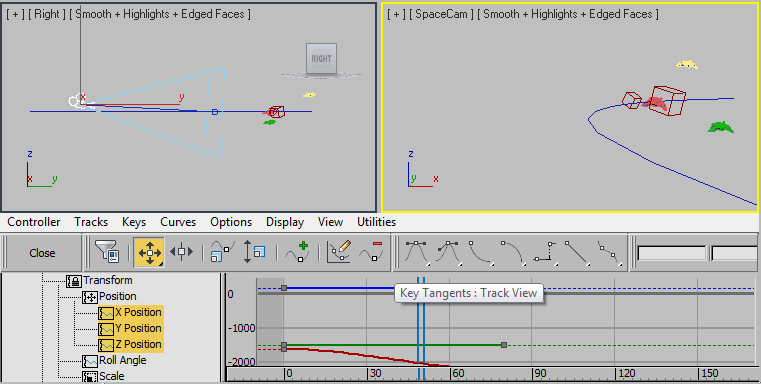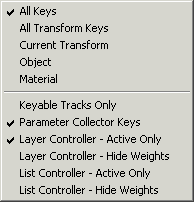The track bar provides a timeline showing the frame numbers (or appropriate display units). It provides a quick alternative to Track View for moving, copying, and deleting keys, and changing key properties. Select an object to view its animation keys on the track bar. The track bar also displays keys for multiple selected objects.

The displayed keys use color coding, so you can easily determine what kind of key exists at that frame. Position, rotation and scale keys are red, green, and blue, respectively, and non-transformational keys such as modifier parameters are gray. You can customize the colors in the Customize User Interface dialog, and depends on the selected/unselected state of the key. The frame indicator is a similar bar displayed in blue.
A key on the track bar can represent any number of animated parameters for the selected objects. Transformations, modifiers, and animated material parameters can all have keys at a particular frame.
To display a list of all keyed values for a key on the track bar, right-click the key. Choose a key type from the right-click menu to display its key properties dialog. Delete keys and filter the track bar display using options on the right-click menu.
The track bar right-click menu contains a submenu that lists any procedural controllers (list controllers, expression, reactors, springs, noise, and so on) assigned to the current object selection. If you select one of the controllers from the submenu, the properties dialog for that controller displays in a modeless dialog.
The track bar can display a waveform (.wav file) that has already been assigned to the sound object in Track View. To display this feature, right-click the track bar
and choose Configure  Show Sound Track. If no waveform is currently assigned to the sound object or if you are using a third-party sound object
plug-in that is not compatible with the waveform display, this part of the track bar is unavailable.
Show Sound Track. If no waveform is currently assigned to the sound object or if you are using a third-party sound object
plug-in that is not compatible with the waveform display, this part of the track bar is unavailable.
You can modify the active time segment by pressing Ctrl and Alt while dragging the track bar. Hold the left mouse button to slide the start of the range, the right mouse button to slide the end of the range, and the middle mouse button to change both the start and end frames together. A tooltip at the cursor and a status bar message will indicate the range you are setting.
 (Auto Key) is active, the time slider background is highlighted red, to indicate that 3ds Max is in automatic keyframing mode.
(Auto Key) is active, the time slider background is highlighted red, to indicate that 3ds Max is in automatic keyframing mode.
You can expand the track bar to show curves. Click  (Open Mini-Curve Editor) at the left end of the track bar. The time slider and track bar are replaced with the controller
and key windows and the Track View toolbars. You can resize the track bar window by dragging the border between the menu bar
and the toolbars (do this in an empty toolbar area).
(Open Mini-Curve Editor) at the left end of the track bar. The time slider and track bar are replaced with the controller
and key windows and the Track View toolbars. You can resize the track bar window by dragging the border between the menu bar
and the toolbars (do this in an empty toolbar area).

Track bar displaying curves
To select keys on the track bar:
If the track bar right-click menu  Configure
Configure  Show Selection Range option is on, when you select multiple keys, the range of the selected keys is shown in the selection
range bar at the bottom of the track bar. You can then scale the selected keys proportionally by dragging either end of the
selection range bar, or move the keys by dragging the center of the bar.
Show Selection Range option is on, when you select multiple keys, the range of the selected keys is shown in the selection
range bar at the bottom of the track bar. You can then scale the selected keys proportionally by dragging either end of the
selection range bar, or move the keys by dragging the center of the bar.
To move or clone keys on the track bar:
While keys are moved or cloned, small lines on the track bar mark the original position of the keys. All keys at a particular frame are moved simultaneously using the following procedures.
To move a single key from a frame with multiple keys:
If, for example, a frame has both a transform key and a material key for the selected object, and only the transform key must move, open the Transform Properties dialog and use the Time parameter to move the transform key.
To delete keys on the track bar:
To delete a single key type on a frame with multiple keys:
An object can have many keys for different animated parameters at a particular frame. Use this procedure to delete a key for a single parameter.
To change the length of the active time segment:
You can change the animation length using track bar.
To hide or show the track bar:
 Show UI
Show UI  Show Track Bar.
Show Track Bar.
This menu item is a toggle: a check mark shows that the track bar is currently displayed.

Dragging with the left mouse button will change the start of the range, dragging with the right mouse button will change the end of the range, and dragging with the middle mouse button will change both the start and the end of the range.
 (Open Mini Curve Editor) to expand the track bar. When the track bar is expanded it displays the Track View menu, toolbars,
controller and key windows. You can hide or unhide UI Elements such as scroll bars as well when this is expanded.
(Open Mini Curve Editor) to expand the track bar. When the track bar is expanded it displays the Track View menu, toolbars,
controller and key windows. You can hide or unhide UI Elements such as scroll bars as well when this is expanded.
Right-click a key on the track bar to display the track bar menu.

Displays the object name and key type for all keys at the current position. Choose any of the keys in the list at the top of the track bar menu to display a key properties dialog. For more information on this dialog, see Key Info (Basic) and Key Info (Advanced).
Displays a Filter submenu. Choose a filter to filter the track bar display; showing only transformation keys, for example.
Right-click anywhere on the track bar, place the cursor over Filter in the track bar menu to display the Filter submenu, then choose filter settings. The settings determine which keys appear on the track bar.

The upper section of the Filter submenu lets you choose one of the following:
The lower section of the Filter submenu lets you toggle each of the following, for any combination of these filter options:
Filters keys related to the Parameter Collector.
This filter lets you see only the keys of the active Layer controller. Otherwise, you see all the keys of all Layer controllers.
This filter hides the weight parameter keys of a Layer controller from the track bar.
Displays a submenu that lets you change the track bar display and behavior.

You can scale all selected keys by dragging either end of the selection range. This lets you change the length of an animation segment while maintaining the relative distance between animation keys. You can also move the selected keys in time by dragging the selection range bar.